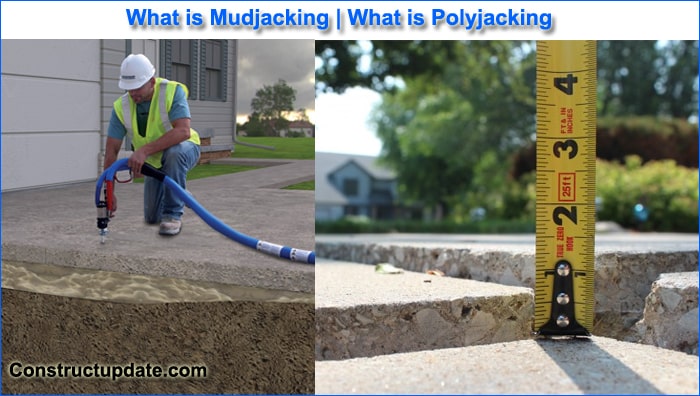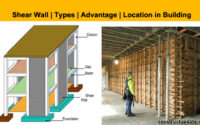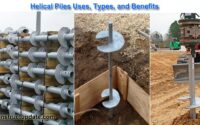What is Polyjacking | Benefits of Polyjacking in Construction | Mudjacking and Polyjacking Similarities
Have you observed unevenness and cracking in your concrete driveway or patio? Concrete that is uneven can harm your home’s structural integrity in addition to being an eyesore. Fortunately, there are solutions to this widespread issue.
Find out the distinction between polyjacking and mudjacking to help you choose the best repair technique for this damage that occurred at home. Continue reading to learn more about poly jacking and mud jacking in construction.
What causes concrete slabs to sink?
Concrete slabs can sink and become uneven for a number of causes, including tree roots, inadequate drainage, and expanding soil. Expansive soil occurs when the soil beneath your home becomes wet and swollen before drying out and contracting later. Seasonal swelling that moves back and forth might harm the foundation of your home.
Your concrete slab will eventually sink and become uneven as a result of this. Neglecting it will make it worse over time. It is even more concerning if your drainage systems are subpar. In this scenario, water will enter the space beneath the slab and wash the dirt your foundation is built on away.
Tree roots may also be to blame for the unevenness of your concrete slab. Ever notice a tree leaning against a sidewalk? Its roots will develop over time and finally begin to crack on the surface, piercing the cement. Your foundation may experience the same thing.

What is Polyjacking
The word “polyjacking” refers to a technique for raising concrete that makes use of a poly-foam material. In this method of lifting concrete, an expanding poly-foam substance is injected underneath your sunken concrete slabs at strategic locations to raise them to their right level and also to give a support material that won’t deteriorate. Depending on the size of the concrete slab that has to be restored, the straightforward procedure can be finished in less than a day.
How does the polyjacking process work, in simple terms?
- In the effected area, make a tiny hole using drill, very small in size.
- High-density foam should be injected into the earth beneath the failed concrete.
- Watch the foam expand as it stabilises the loose, uncompacted dirt.
- Go back to normal life!
The reason polyjacking is so well-liked is that it can raise concrete that has sunk to its “former splendour” while simultaneously making it durable enough to endure more wear and tear. A slab raised using polyjacking will be more durable, stable, and water-infiltration resistant.
How long does it take polyjacking to lift a concrete slab?
An hour or two is often needed to complete a domestic concrete lifting project from beginning to end. Only around 15 minutes are spent actually polyjacking; the rest is setup and cleanup.
Benefits of Polyjacking in Construction
Polyjacking has the following primary advantages in construction:
- The expensive procedure of replacing concrete surfaces is avoided through polyjacking. Polyjacking is hence economical.
- The surface can be used in a few hours because the drying process is quicker.
- The procedure keeps the concrete surface’s compressive strength and structural integrity.
- It stops future heaves by caulking joints and cracks.
- A substance that is good to the environment, polyurethane contains 39 to 49% recycled and renewable components.
- A clean working environment is produced because there is no concrete or grout splatter during the procedure.
What is mud jacking? How does it work?
The practise of mudjacking has been around for around 75 years now. Concrete slabs that have sunk beneath patios, pool decks, and foundations can be raised using this technique. To level out the concrete slab, a slurry comprised of dirt, water, and cement is injected underneath it. It’s a simple fix that can be completed in a matter of hours.
Mudjacking cannot and should not be used to raise foundations themselves, it should be noted. Mudjacking is also not recommended when the concrete slab is already deteriorated because it could result in more damage.
What are the advantages of mudjacking then? Here are a few examples.
Mud jacking is Cost-Effective and Fast
Mudjacking is substantially less expensive than replacing concrete. Mudjacking can also be completed in a day in as little as 3 hours around. You should keep in mind, though, that you can only accomplish so if your concrete slab is free of current damage. If so, the inspector would advise replacing the concrete slab. If you don’t, your family and your home are both in danger.
Mudjacking and Polyjacking Similarities
You should be aware of the similarities between mudjacking and polyjacking:
Both of them are cheaper than a full replacement.
Yes, you can simply replace the entire concrete slab itself rather than using either mudjacking or polyjacking. That costs more than two of the costs of the combined method, though.
Additionally, the replacement procedure can be quite time-consuming and intrusive. Additionally, it’s possible that repairing the concrete slab is unnecessary and a waste of time and money.
Both methods reuse the existing concrete.
Both options are less wasteful and environmentally friendly than replacing the concrete slab, so if you’re an environmentalist, you might prefer them. This is so that the concrete slabs used in both techniques are not wasted. Additionally, the concrete slab that was hurled will require additional room in a landfill. So, if you value nature, you probably won’t enjoy that.
Both methods use a similar concept.
The way that these approaches function is another commonality. Here, the word “jacking” should be noted. It means that they both use a suitable material to pump under the concrete slab when lifting or moving it. Despite the fact that they function in the same way, they are distinct enough to stand alone.
So, which concrete repair method is best for your project?
Both approaches employ the same principle but utilise various materials, various installation techniques, and special features. Both of them are less expensive options than removing and replacing the concrete slab. Polyjacking is the best option if your project is minimal in scope. But when it comes to larger operations, mudjacking is a sure thing.




